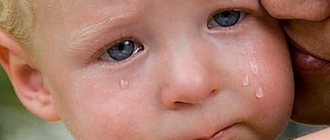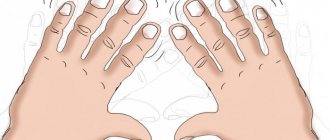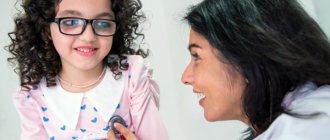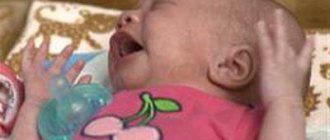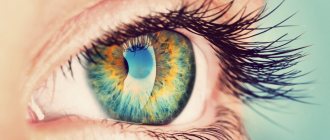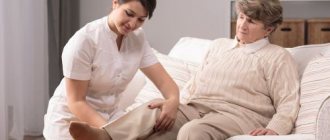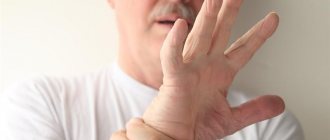According to WHO instructions, a newborn is considered a child up to the 28th day of life. This little man is just learning to adapt to a completely new world. The nervous system is especially stressed in the first days. The newborn adapts its reactions to its environment, exhibits the required physiological reflexes, and often has muscle tone in its arms and legs. Some signs that are alarming for older children are, in most cases, the norm for newborns. These symptoms include slight trembling of the limbs and chin - tremor.
What is newborn tremor
This is what is called muscle tremors in newborns. This disorder appears from the first day of life and looks like periodic muscle contractions, following one after another. Most often you can see tremor of the chin and lips in newborns; tremor of the hands in infants is slightly less common. Trembling of the head is considered a warning sign: such a symptom may indicate neurological pathologies.
Tremors can be:
- asymmetrical (only one arm or leg shakes);
- symmetrical (both limbs tremble; chin and lower lip).
Small twitches do not continue constantly, but occur at moments of tension: waking up, getting dressed, hunger, discomfort. In some infants, muscles contract uncontrollably during REM sleep. Non-dangerous physiological manifestations last up to 30 seconds, muscle contractions are fast and rhythmic, the baby is conscious.
What is the reason
Although the external manifestations are the same - minor tremors, the reasons for its appearance vary. The main reasons why the chin and limbs shake in newborns are immaturity of the nervous system, hypoxia, and prematurity.
Prematurity
Even if a healthy baby’s nervous system experiences a colossal load, for children born prematurely this load increases even more. After all, the nervous system of a premature baby has not gone through all the intrauterine stages of formation, and the baby has to adapt to the conditions of external existence ahead of time.
Did you know? Typically, uncontrolled muscle trembling in newborns goes away on its own by the age of 3-4 months. If the cause of the symptoms is associated only with immature physiology, then trembling does not occur in a calm state, but only during situations associated with emotional arousal: fear, joy, change of activity, awakening, hunger.
In a newborn, the myelin sheath of nerve fibers is not the same as in an adult. Therefore, the speed of impulse transmission to the muscles also differs. The faster the impulse is transmitted, the smoother and more coordinated the movements become, and the less likely it is that twitching will occur.
conclusions
Tremor occurs in every second newborn. Up to three months this is quite normal. Most often, this phenomenon is observed in children born prematurely. It happens that a newborn's chin shakes when crying. There is no need to be afraid if the tremor lasts a few seconds.
In pathologies, tremor is observed in a calm state, lasts quite a long time, intensifies, becomes more intense and affects the baby’s head, arms and legs. Only a pediatrician or pediatric neurologist can diagnose the pathology and determine treatment. The doctor will recommend a massage complex to the mother that will help relieve the baby from the disease.
How you can help your child cook more confidently and get rid of chin tremor is described in the video:
What diseases can tremor be a symptom of?
The location where the trembling occurs may be an indirect indication of the cause of the disorder. For example, lips often tremble in premature babies, as a result of insufficiently formed nervous processes.
In general, trembling of the lips and chin, if it occurs with excitement, crying, fear, in children under four months, is considered normal. In this case, the chin and lips tremble from tension or emotional stress that has overexcited the nervous system. However, if this occurs in the absence of crying or excitement, then it is possible that the newborn is subject to excessive muscle tension - “muscle hypertonicity.”
Tremor of the arms and legs in newborns is evidence of excessive release of norepinephrine by the adrenal glands. This is how an excessively strong reaction to various stress factors manifests itself. The lower limbs tremble much less frequently than the arms. The history of such babies often includes prematurity, birth trauma, and cerebral hypoxia.
If the limbs tremble, consultation with a pediatrician and neurologist is necessary, as parents may confuse tremor with seizures. Convulsive muscle contractions, in contrast to physiological tremors, are a sign of serious developmental pathologies.
Head trembling , if it is not caused by hunger, discomfort or emotional stress, is an alarming symptom. Especially if such manifestations have not decreased by the age of three months. This may be a sign of a dysfunctional state of the endocrine or nervous systems.
The arms, head and chin may tremble if you have the following health problems:
- increased intracranial pressure;
- with magnesium deficiency in the body - hypomagnesemia, neuromuscular excitability increases, spasms, cramps and tremors appear in the muscles;
- provokes the problem of hypocalcemia (lack of calcium) due to insufficient external supply of this trace element with milk;
- in case of malabsorption in the intestines, with stool disorders;
- elevated blood sugar levels – hyperglycemia;
- brain damage;
- infectious diseases;
- traumatic brain injury.
Dangerous convulsions
Convulsions in a newborn may not be so harmless and indicate the development of a serious disease of the nervous system. But in a serious illness, convulsive syndrome is far from the only symptom. Muscle hypertonicity, impaired coordination of movements, developmental delays, frequent regurgitation, etc. may be observed. In children under one year of age, the following diseases cause seizures:
- metabolic disorders (lack of calcium, magnesium, low blood glucose concentration, increased bilirubin);
- impaired metabolism of amino acids, vitamins, fats or carbohydrates;
- increased intracranial pressure;
- encephalopathy of the hypoxic type;
- cerebral hemorrhage;
- sepsis.
In infants, convulsive syndrome is more accompanied by motor activity than in newborns.
High fever during illness can cause febrile seizures in young children.
Another dangerous type of seizure is febrile. They occur during infectious diseases (ARVI, pneumonia, otitis media) accompanied by fever. Their appearance is the body’s reaction to high temperature in children aged 6 months to 3 years. If a child at the age of 1 had similar attacks against a background of fever, before the age of 2, such children are recommended to bring down even a low body temperature within 37.5 oC.
Treat or wait
Excessive tension and slight trembling indicate increased excitability of the baby and insufficiently formed self-regulation of the nervous system. Despite the fact that trembling is considered normal for newborns, it is necessary to report it to your pediatrician.
Important! A pathology that must be treated is considered to be trembling of the limbs in an infant after the age of four months.
Treatment is also necessary if the newborn shakes his hands regardless of the situation, and over time this shaking only intensifies; if trembling of the limbs is accompanied by tremors of the head and lower lip of the infant.
Seek medical help if you have one or more of the following signs:
- trembling covers the limbs, face and head, there is a feeling that the newborn is shaking all over;
- shaking lasts longer than 30 seconds;
- asymmetrical twitching (chin and one leg or one arm);
- during an attack, the skin turns pale to blue, the baby becomes covered in perspiration;
- the child turned 4-5 months old, and the trembling did not stop.
In all these cases, parents need to contact a pediatric neurologist who will prescribe comprehensive treatment. Therapeutic procedures include special gymnastics, massage, exercises in water, and medication.
The body of a newborn is a very plastic system; with proper and timely treatment, many of its functions are restored and return to normal. If you follow all medical recommendations, then in the absence of serious pathologies, the baby’s nervous system will strengthen and the twitching will disappear. Physiological tremor in newborns is easy to treat. If you let everything take its course, then in the future, headaches, problems with posture, fatigue and other health problems are quite possible.
Doctors' recommendations
Tremor in newborns, although a variant of the norm, still worries parents. And although this is not a pathology, but a temporary physiological condition, such a baby requires the right approach.
General recommendations from doctors will be as follows:
- To exclude pathologies and for your own peace of mind, be sure to discuss the involuntary movements of the newborn with your pediatrician. If, in addition to the chin, the limbs and head are trembling, then the advice of a pediatric neurologist is absolutely necessary. In any case, a planned examination by this specialist should take place during the “critical” periods: in the third, sixth and ninth months of life. These are moments of special vulnerability for the baby’s nervous system.
- Minimize or eliminate situations in which the newborn experiences any discomfort. Create a calm atmosphere in your home, eliminate stress factors (sharp sounds, screams, bright lights, many visitors).
- The newborn should receive a relaxing massage twice a day.
- Two or three times a week, bathe your child in warm baths with soothing herbal infusions (mint, lemon balm, oregano, valerian).
- Almost constant and calm physical contact with the mother is important, especially when the baby falls asleep or eats.
- Following a routine for your newborn creates predictability and helps you adjust more quickly to the transition from one activity to another.
- Twice daily walks in the fresh air are also required to saturate the newborn’s tissues and organs with oxygen.
Compliance with such simple therapeutic measures stabilizes and improves self-regulation processes in the newborn’s body. In some cases, the doctor may prescribe pharmacological agents. The action of the drugs is aimed at relaxing and optimizing oxygen access to all body systems.
Mom's hands are the best medicine
Of course mothers worry about their children! But baby tremor is an absolutely natural phenomenon for babies. And more often mothers panic when there is nothing to be afraid of.
But, nevertheless, the matter concerns the child, and it is better to play it safe once again and go to an appointment with a specialist. The doctor will examine the baby, and then prescribe balneotherapy or massage, recommend swimming or children's yoga. Massage is also effective for intestinal colic (see this material).
The best effect can be achieved with massage. When performing it, you must remember that a newborn is a fragile creature, every movement must be performed very carefully so as not to harm the baby.
https://youtu.be/aluvE9lLwrY
Before performing a massage, you should prepare a little. For this:
- Never massage when your baby is tired and wants to sleep.
- During the entire process, talk to him, tell fairy tales, poems, sing songs.
- Open the window and let fresh air into the room.
- Remove all scratching objects from your hands so as not to injure the baby, warm your hands.
- Place the child in a comfortable environment so that nothing disturbs him.
- For massage, use only baby creams and lotions, so as not to provoke allergies and possible rashes, the causes of which can be found here.
- Accompany the massage movements with stroking.
- Start with the baby's face, do not forget to rinse the baby's nose in advance.
Massage technique
Exercises if the baby is lying on his back:
- Mom, taking his right leg, taps it with her fist, from bottom to top;
- With one hand we fix the baby’s hand, with the other we hold him by the shoulder. I shake the handle slightly, slowly lowering it to the wrist;
- We draw a circle on the baby’s tummy, strictly clockwise .
Movements if the baby is lying on his stomach:
- gently stroke it along the spine, starting from the neck and ending with the tailbone;
- You need to place your favorite toy in front of the baby so that he reaches for it. This will allow you to use your neck and back muscles. And then we gently knead the baby’s butt with our fists.
